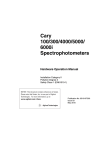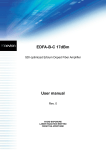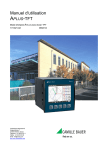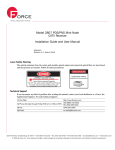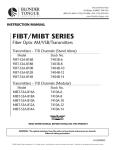Download PONA 2114 - 2127 - Jenco Technologies
Transcript
PONA 2114 - 2127 Rack Mounted Erbium Doped Fiber Amplifier User’s Manual 21061785r001 August 30, 2005 EMCORE CORPORATION 2015 W. Chestnut St Alhambra, CA 91803 Tel: (626) 430-4000 Fax: (505) 430-4060 www.emcore.com PONA Manual 21061785r001 30 August, 2005 Table of Contents Table of Contents .................................................................................................................................. 2 1.0 Introduction............................................................................................................................................. 3 1.1 General ................................................................................................................................................ 3 1.2 Technical Support................................................................................................................................ 3 1.3 Features and Bebfits …………… ..…… …………………………………………………………….3 1.4 Description………… …..……………… .… … ……………………………………………….……3 1.5 Electrical and Optical Specifications…...….………………………..…………………………….…..4 1.6 General Mechanical Specifications..….…………………………………………………………….….4 1.7 Outline Drawing………………..…….……………………………………………………………..….5 1.8 Ordering Information………………….………………………………………………………….. .….6 1.9 Laser Safety Compliance …..……….……………………………………………………………….7 1.10 EMI/EMC Compliance……..……….…… ………………………………………………………….7 1.11 Low Voltage Directive Compliance….……………………………………………………………….7 2.0 PONA Installation................................................................................................................................. 11 2.1 Unpacking ........................................................................................................................................... 7 2.2 PONA Mounting and Power Connection ............................................................................................ 8 2.3 Optical Connections and unit Verification .......................................................................................... 8 3.0 PONA Controls, Indicators, and Alarms............................................................................................... 10 3.1 PONA Controls and Indicators.......................................................................................................... 11 3.2 Alarm Description ............................................................................................................................. 13 4.0 Troubleshooting .................................................................................................................................... 17 4.1 Fuse Replacement…………………………………………………………………………….……18 2 PONA Manual 21061785r001 1.0 Introduction 1.1 General 30 August, 2005 The PONA 2100 series Erbium Doped Fiber Amplifier (EDFA) is the ideal equipment for amplifying optical output from 1550 nm CATV laser transmitters with minimal degradation of analog performance. It is also completely rack-mountable, allowing turnkey operation. The power supply source and optical signal to be amplified are the only required inputs. 1.2 Technical Support In case of technical difficulties, which cannot be solved by following troubleshooting procedures as listed in Section 4; please contact the technical support organizations. USA 1.3 • • • • • • • • • • • • 1.4 Ortel a division of Emcore One Ivybrook Blvd, Suite 150 Warminster, PA 18974 Phone: (215) 672 8973 Website: www.emcore.com FEATURES & BENEFITS Fully Functional 1U Rack Mount Erbium-Doped Fiber Amplifier Low Noise Figure (Typical <5dB) Total Input Power Range –10 dBm to +12 dBm +14 dBm to +27 dBm Output Power Optional Internal Optical Power Splitters Standard RS-232, RS-485 or I2C Communications Standard and Optional Gain Flatness (1530nm - 1562nm) Low Electrical Power Consumption LCD Panel Status Indicator Input / Output Isolation > 40/40 dB Polarization Dependant Gain < 0.1 dB Polarization Mode Dispersion < 0.5 ps DESCRIPTION The Ortel PONA 2100 Fiber Optical Amplifier Module is an ideal building block for OEM system integrators. PONA 2100 Optical Amplifiers is designed to meet the most demanding noise performance requirements of CATV applications. PONA 2100 performs all the functions required from an optical amplifier for system integration. PONA 2100 optical amplifier provides optical isolation on the input and output of the gain block for stable, low noise operation. The input and output optical signal power levels are detected for monitoring and control. The input optical signal is amplified with active gain control for a constant output power level, or with active output power control for constant gain mode. PONA optical amplifier also provides monitors and associated alarms for all vital characteristics of the optical amplifier. 3 PONA Manual 21061785r001 1.5 30 August, 2005 ELECTRICAL/ OPTICAL SPECIFICATIONS PROPERTY SYMBOL (UNIT) COM MENTS LIMIT PONA 2100 MODELS Product Code 2114 2117 2120 2122 2124 2126 2127 PERFORMANCE (note 1) Operating Input Power Pin (dBm) Max +12 +12 +12 +12 +12 +12 +12 Operating Input Power Pin (dBm) Min -10 -10 -10 -10 -10 -10 -10 Min 0 0 0 0 0 0 0 r Input Power Pin (dBm) Nominal Output Power Po (dBm) Noise Figure NF (dB) Typ/Ma 14.0 17.0 20.0 22.0 24.0 26.0 27.0 +/-.25 +/- .25 +/- .25 +/- .25 +/- .25 +/- .25 +/- .25 Nominal 4.5/5.0 4.5/5.0 4.5/5.0 4.5/5.0 5.0/5.5 5.0/5.5 5.0/5.5 (note 2) x Static Gain Flatness Dynamic Gain GF (dB) Max +/-0.5 +/-0.5 +/-0.5 +/-0.5 +/-0.5 +/-0.5 +/-0.5 (note 3) (dB) Max +/-1 +/-1.25 +/-1.5 +/-2.0 +/-2.0 +/-2.0 +/-2.0 (note 4) (dB) Max +/- 0.2 +/- 0.2 +/- 0.2 +/- 0.2 +/- 0.2 +/- 0.2 +/- 0.2 (note 5) Psys(W) Max 5 7 9 12 20 27 32 50oC Case Flatness Output Power Stability Power Consumption (steady state regime) Note: 1) Unless stated otherwise all specifications apply over the full temperature range and humidity 2) Measured with 8 evenly spreaded signals @ 25°C, ΣPin = 0 dBm (see attachments 1, 2, 3) Low Noise Figure option with NF = 4/4.5 dB is available for some Models 3) Measured with a swept Probe Signal (Pp), where Pp = 0 dBm @ 25°C 4) Measured with a swept Probe Signal (Pp), and a fixed Tone Signal (Pt) @ 1545 nm; (Pt = Pp+20 dB; Pt + Pp = 0 dBm) @ 25°C; Gain Flattened Option with ∆G = +/-0.5dB is available for some Models (01 Gain flattened option only) 5) Stability over polarization and temperature 1.6 GENERAL / MECHANICAL SPECIFICATIONS PROPERTY GENERAL Operating Wavelength Operating Case Temperature Storage Temperature Operating Humidity Voltage Supply Range REQUIREMENT COMMENTS 1530 ~ 1564 nm Standard 0°C to 50°C -40°C to 85°C 20% to 85% 100 VAC to 240 VAC 50/60 Hz Standard Standard Non-condensing Standard -36 to –60 V DC Optical Connectors Dimensions In Inches SC/APC; SC/UPC; FC/APC; FC/UPC; E2000/APC 19.0”W x 14.76”D x 1.72”H Optional User Specified 19’’ Rack Mounted, 1U 4 PONA Manual 21061785r001 1.7 30 August, 2005 OUTLINE PONA 2100 DRAWINGS: AC and DC versions shown below with 8-port option. 5 PONA Manual 21061785r001 30 August, 2005 1.8 ORDERING INFORMATION PONA 21 - - - - * Optical Output Power Output Ports Input Voltage Connector GFF/ NF options 14 - 14 dBm 1 AC – 90-260V 50/60 Hz 00 - standard 17 - 17 dBm 2 DC – 48 V SC - SC/APC (8 degree connector) (Default Option FC - FC/APC (8 degree connector) 20 - 20 dBm 22 - 22 dBm 4 8 (Note 6) 24 - 24 dBm (Note 7) 26 - 26 dBm (Note 7) 27 - 27 dBm (Note 7) 01 – Gain Flattened option EC - E2000/APC TC - SC/UPC ( flat polished ultralow backreflection) GC - FC/UPC ( flat polished ultralow backreflection * ---- The part number PONA 2114 -1-AC-00 -MOD - stands for a preamplifier without input optical power monitoring and input optical isolator. It should have the Noise Figures <=3.3dB (measured at input optical power of Pin = –30 dBm). This unit has an optical output power of 14 dBm and doesn’t have any restrictions on the input optical power signal. * ---- The part number PONA 2117 -1-AC-01 -MOD - stands for a mid-span access booster DWDM amplifier. It should have the Noise Figures <=5.5dB (measured at input optical power of Pin = - 6 dBm). This unit has max. dynamic gain flatness of +/-0.8 dB (at operating wavelength from 1540 nm to 1560 nm) optimized for total optical input power of –6 dBm. 6 PONA Manual 21061785r001 30 August, 2005 (Note 6) The maximum number of output ports when using E2000 connectors is four. All other optical connectors allow for the eight port option. (Note 7) 24-27dBm PONA 2100 series EDFA’s should be ordered in four and eight port options to avoid permanent optical connector damage due to high power intensities and dirt contamination. For exact model number, please contact your sales representative. 1.9 LASER SAFETY COMPLIANCE The PONA2114 to PONA2127 products conform to Class IIIb requirements of FDA-CDRH CFR1040 and Class 3B requirements of IEC 60825-1, under both normal operating and single fault conditions. 1.10 EMI/EMC/ESD COMPLIANCE The PONA2114 to PONA2127 products fully comply with the EMI/EMC requirements set forth in the following European and North American standards. EN 55013 – Electric Field Radiated Emissions EN 55013 – Conducted Power Line Emissions EN 61000-3-2 – Harmonic Emissions FCC, Subpart B of Part 15, Class A Unintentional Radiators EN 61000-4-3 – Radiated Field Immunity, Criteria A EN 55020 – Conducted Immunity, Criteria A 1.11 LOW VOLTAGE DIRECTIVE COMPLIANCE The PONA2114 to PONA2127 products fully comply with the LVD requirements set forth in the following European and North American standards. BS EN60950: 1997+A4: “Safety of Information Technology Equipment, including Electrical Business Equipment” CAN/CSA-C22.2 No. 60950-00-UL 60950: March 15, 2002: + A4: “Safety of Information Technology Equipment”. 2.0 PONA Installation 2.1 Unpacking Inspect the shipping boxes for any obvious damage. Unpack the unit from all packaging boxes. Inspect the appearance of the unit for any shipping damage. 7 PONA Manual 21061785r001 30 August, 2005 In case of damage, document and inform the shipping company and your local representative, as seen in section 1.2. Save the shipping boxes and their inserts for any future reshipment for upgrade or repair. NOTE: In the event of a reshipment back to the manufacturer, any additional damage caused by not using the original boxes will be considered the responsibility of the customer. 2.2 PONA Mounting and Power Connection 1. 2. 3. 4. 5. 2.3 Mount the unit into a 19-inch wide rack or cabinet. Turn the unit power supply switch located on the rear panel off. See section 3.0 as needed. Turn the key switch located on the front panel to the OFF position. AC powered models: Plug the power cord supplied with the Unit into the three-prong connector on the rear panel and place the other end of the power cord into a 100-240 VAC, 50-60 Hz power source (e.g. wall socket). DC powered models: Slightly loosen the screws labeled –48V and –48V RTN. Place a wire under the screw labeled –48V RTN and tighten the screw. Attach the opposite end of the wire to a ground terminal on a –48V DC power supply (-36 to -60V). Place a wire under the screw labeled –48V and tighten the screw. Attach the opposite end of the wire to a –48V terminal on a –48V DC power supply. Turn on the DC power supply. Turn the unit power switch to the ON position. Optical Connections and Unit Verification (requires a 1550 transmitter or other optical source) 1. Clean all fiber patch cords before connecting to the PONA. Cleaning Guidelines: Fiber Patch cord connectors - Remove the fiber connector dust cap and wipe the fiber connector tip with a dry lint-free cloth (such as Kimwipes). Inspect for scratches or debris on connector surface by using a fiberscope. - If no scratches or debris are found the connector is now clean and ready for connection. If debris or scratches are found then repeat the fiber patch cord connector cleaning guidelines. Fiber Bulkhead connectors - Compressed air may be used to clean fiber bulkhead connectors. Use compressed air with at least the - following specifications: -Non-residue, inert gas for precision dust removal - Ultra-filtered to < 0.2 microns - Recommended for optical systems - Using compressed air as listed above, remove the bulkhead dust cover and hold the can of compressed air about 6 inches from the connector. After spraying a few short bursts into the bulkhead the connector is clean and ready for connection. - If compressed air is not available, the PONA‘s fiber bulkhead connector may be cleaned by 2.5 mm cotton swap or connector plate may be removed to clean the internal fiber patch cords. CAUTION: Use caution when handling fibers. Do not exceed fiber manufacturers pulling tension or bend radius specifications when removing fiber bulkhead connector plate. - To remove the PONA optical connector plate, remove the screw on the far left of the optical plate and 8 PONA Manual 21061785r001 30 August, 2005 2. remove the screw on the far right of the optical plate. Do not remove the screws on the optical bulkhead connector. See section 3, rear panel item 6 for PONA optical bulkhead connector configuration. - Slowly remove the optical connector plate from the rear panel and disconnect each fiber connector from the bulkhead mounted on the plate - Clean each fiber connector according to section 2.3.1 of the fiber cleaning guidelines. Make sure the laser key switch on the front panel of the PONA is in the OFF position. 3. Connect a fiber patch cord from the output of the transmitter to an optical power meter. 4. Turn the transmitter laser key switch to the ON position and use a serial port connection to make sure the 1550 Transmitter or other optical Source PONA 2000 Patch cord # 1 Patch cord # 2 parameters are set for proper operation. 5. Using the optical power meter verify the transmitter optical power is within specification. 6. Turn the transmitter laser key switch to the OFF position. 7. Remove the optical patch cord from the power meter and plug the patch cord into the PONA input optical connector (follow the diagram below). 8. Connect a patch cord from the output of the PONA to an optical power meter. 9. Turn the laser key switches on the transmitter and PONA front panel to the ON position. 10. Using the optical power meter verify the optical output of the PONA is within specification. Note: difference in patch cords may result in slightly different optical power measurements. 11. Turn off the PONA laser key switch. 12. Remove the patch cord from the optical power meter and plug the patch cord into the fiber for the link being deployed. 13. Turn the PONA laser key switch to the ON position. 9 PONA Manual 21061785r001 30 August, 2005 PONA Controls, Indicators, and Alarms 13 10 11 7 12 6 8 13 7 9 1 5 3 4 2 10 PONA Manual 21061785r001 3.1 PONA Controls and Indicators Table 1. Item 30 August, 2005 Label PONA Controls and Indicators Function 1 Alarm Green (No Alarm) indicates that adequate optical input power is present and the PONA has the pump ON and is functioning normally. Flashing Green (waiting temp) This means that the pump is waiting for the laser temperature to stabilize. OFF (configured off) The PONA pump mode parameter has been left in off mode (rather than constant current or constant power). Steady Yellow (Minor Alarm) indicates that one or more parameter is near an operational limit without affecting the operation of the PONA. This can also mean that the key switch is in the off position. Yellow (flashing) indicates that the key switch is turned on but pump is not in a steady state region yet. Red (Major Alarm) indicates that one or more parameter is outside of an operational limit, which affects the operation of the PONA. See Table 2 in Section 4 for more detailed description of alarm conditions The PONA will shut down under certain alarm conditions. After shutdown, the PONA may automatically power up if the alarm conditions return to normal. 2 LASER key switch ON position---Pump is enabled and can provide optical amplification when the key is turned to this position. The LED will flash yellow for a few seconds when the key switch is turned, indicating the pump is not yet in a steady state. OFF position---Pump is off. Yellow LED should be lit. 3 DISPLAY/NEXT Pushing this button changes the LCD to the next display mode. If there is a current alarm, this button will cycle the display to the next of the currently active alarms. Note that any new arriving alarms always cause the display to change. Refer to Table 2 section 4 for descriptions of alarm states. If there are no pending alarms, the next key allows cycling through the following live-updating data: g laser cur shows the laser current in mA. g laser vol shows the laser voltage in V. g bk facet shows the back facet current in uA. g TEC cur shows the TEC current in mA. g TEC vol shows the TEC voltage in V. g las temp shows the temperature of the laser in degrees C. g unit temp shows the temperature of the pump case in degrees C. g in power shows the composite input optical power in dBm . g out power shows the composite output optical power in dBm . g descriptor shows the 16 character configured descriptor, which is essentially the unit’s name (like “PONA 2022S”) g serial number shows the 16 character factory-set serial number. 11 PONA Manual 21061785r001 30 August, 2005 The last parameter in the list is one of the following based on the configuration of the unit as either constant power or constant current: g const cur show the configured pump current in mA. g const pwr shows the configured PONA optical output power set point in dBm. Note: Start up messages and the revision level of the firmware in the unit are shown as the unit powers up. 4 DISPLAY ADJUST When there are no alarms and the display is showing const cur, the UP and DOWN arrows raise or lower the laser current output in increments of 1 mA for each press of the button. Adjustments, which would directly trigger alarms or cause laser current to exceed configured limits, are not allowed. When there are no alarms and the display is showing const pwr, the UP and DOWN arrows raise or lower the output of output power controller in increments of 0.25 dB per each press of the button See the EDFA specifications to determine adjustable power range. RESET returns either the constant power or constant current setting back to the factory-preset level.. 5 (none) LCD that displays status information. Can be used with the DISPLAY/NEXT button. 6 OPTICAL Connection locations for the input fiber and output fiber with the proper type of optical connector (FC/APC, SC/APC, or E2000/APC) for the purchased model. (multiple output versions not shown). 7 SERIAL PORT Reserved for factory diagnostics, do not use without consulting the technical support organization. 8 1/0 On/Off switch for AC powered units. Allows the unit to be fully shut off (i.e. no electrical power entry). 9 INPUT POWER IEC AC power plug with in-line fuse holder for connection to a standard three-pronged, UL approved power plug. 10 GROUND PONA chassis ground lug. Should be attached to chassis ground of DC –48V power supply. 11 INPUT POWER Input power connections for –48 V DC input. 12 1/0 On/Off switch for DC powered units. Allows the unit to be fully shut off (i.e. no electrical power entry). 12 PONA Manual 21061785r001 13 FUSE 2A 3.2. Alarm Description 30 August, 2005 Fuse holder for –48 V DC units. Push holder in and turn ¼ turn to left to release fuse. AC units use screwdriver to remove fuse holder via prying open the fuse holder. Table 1. PONA LCD/Alarm/Status Descriptions The alarms, comparing values to limits, generally have a warning limit level that if exceeded cause the status LED to be yellow (if there is no pending alarm limit), exceeding an “alarm” or Major condition causes the status LED to be red. As alarms occur, they will be reported on the LCD display. Meaning LCD alarm Laser Temp Hi Laser Temp Low Alarm or warning for hi limit Alarm or warning for low limit Laser Current Hi Alarm or warning for high limit Laser Current Lo Alarm or warning for low limit Unit Temp Hi Alarm or warning for high limit Unit Temp Hi Alarm or warning for low limit +5 Volt Hi Alarm - this is a fixed value alarm set at 5.5 volts (no warning) +5 Volt Lo Alarm - this is a fixed value alarm set at 4.5 volts (no warning) Opt In Pwr Hi Alarm or warning for high limit (see the PONA Test Data Sheet, default level is 12.5 dBm) Opt In Pwr Lo Alarm or warning for low limit (see the PONA Test Data Sheet, default level is –10.5 dBm) Note: The pump will be shut off during any time the input optical power is found to be below the low alarm limit Opt Out Pwr Hi Alarm or warning for high limit (see the PONA Test Data Sheet, default level is 22.5 dBm) Opt Out Pwr Lo Alarm or warning for low limit (see the PONA Test Data Sheet, default level is 19.5 dBm) 3V Pwr Bad There is no settable parameter for this error condition. The alarm occurs when the internal 3.3 volt power is read as either more than 0.1 volt too high or too low 13 PONA Manual 21061785r001 Keyswitch Off 30 August, 2005 This alarm will be reported whenever the keyswitch is found in the off position. Note that this alarm will always cause the pump to be shut down. 4.0 Troubleshooting Low EDFA Optical Output Power Yes Apply power according to section 2.2 of this manual. No Is rear panel ON/OFF switch in ON position? Yes Continue Testing Yes Is Optical power OK? No Is front panel key switch in the ON position No Turn front panel key switch to on position. See Table 1, Item 2 in this manual. Yes Clean the optical connectors according to section 2.3 of this manual. No Have the optical connectors been cleaned ? No Is Optical power OK? Yes Continue Testing Yes Continue Testing Yes Continue Testing Yes Is Optical power OK? No Is input optical power within operational limits of the transmitter? No Adjust input optical power within operational limits of the EDFA. Yes Press the recessed RESET button on the front panel. See Table 1 item 4 in this manual. Continue Testing Yes Is Optical power OK? Yes No Has the optical output power been adjusted down at the front panel? Call Technical support as described in section 1.2 of this manual. No Is Optical power OK? 14 PONA Manual 21061785r001 30 August, 2005 4.1 Fuse Replacement: If the unit will not power up with either an AC input specified from (100 – 240VAC 50-60Hz for AC version units) or via (48VDC specified from 36-60VDC for DC power version units) the units internal fuse may have blown. Disconnect all power from unit before attempting to replace any fuses! To replace the fuse for the AC version units locate the power entry module on the rear of the unit. On page 13 item bullet 13 is were the fuse is located. Use a screwdriver to push open the fuse holder. From here the fuse can be released and replaced with an approved F2.5AH250V or equivalent type fuse. Install the replacement fuse back into the holder. Power up the unit, if the fuse blows again or unit will not power up the unit must be returned to the factory. To replace the fuse for the DC version units locate the power entry module on the rear of the unit. On page 13 item bullet 13 is were the fuse is located. Use a screwdriver and push holder in and turn ¼ turn to left to release fuse. Replaced fuse with an approved F2.5AH250V or equivalent type fuse. Install the replacement fuse back into the holder and tighten. Power up the unit, if the fuse blows again or unit will not power up the unit must be returned to the factory. 15
















